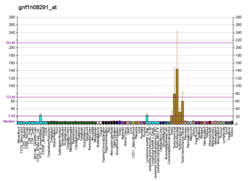SPACA3
Sperm acrosome membrane-associated protein 3 is a protein that in humans is encoded by the SPACA3 gene. It may be involved in adhesion to the egg before the egg is fertilized.[5][6]
References
- 1 2 3 GRCh38: Ensembl release 89: ENSG00000141316 - Ensembl, May 2017
- 1 2 3 GRCm38: Ensembl release 89: ENSMUSG00000053184 - Ensembl, May 2017
- ↑ "Human PubMed Reference:".
- ↑ "Mouse PubMed Reference:".
- ↑ Mandal A, Klotz KL, Shetty J, Jayes FL, Wolkowicz MJ, Bolling LC, Coonrod SA, Black MB, Diekman AB, Haystead TA, Flickinger CJ, Herr JC (Apr 2003). "SLLP1, a unique, intra-acrosomal, non-bacteriolytic, c lysozyme-like protein of human spermatozoa". Biol Reprod. 68 (5): 1525–37. doi:10.1095/biolreprod.102.010108. PMID 12606493.
- ↑ "Entrez Gene: SPACA3 sperm acrosome associated 3".
Further reading
- Niyonsaba F, Ogawa H (2006). "Protective roles of the skin against infection: implication of naturally occurring human antimicrobial agents beta-defensins, cathelicidin LL-37 and lysozyme". J. Dermatol. Sci. 40 (3): 157–68. doi:10.1016/j.jdermsci.2005.07.009. PMID 16150577.
- Cramer EM, Breton-Gorius J (1987). "Ultrastructural localization of lysozyme in human neutrophils by immunogold". J. Leukoc. Biol. 41 (3): 242–7. PMID 3470418.
- Welsh IR, Spitznagel JK (1973). "Distribution of lysosomal enzymes, cationic proteins, and bactericidal substances in subcellular fractions of human polymorphonuclear leukocytes". Infect. Immun. 4 (2): 97–102. PMC 416271. PMID 5154881.
- Ibrahim HR, Matsuzaki T, Aoki T (2001). "Genetic evidence that antibacterial activity of lysozyme is independent of its catalytic function". FEBS Lett. 506 (1): 27–32. doi:10.1016/S0014-5793(01)02872-1. PMID 11591365.
- Strausberg RL, Feingold EA, Grouse LH, et al. (2003). "Generation and initial analysis of more than 15,000 full-length human and mouse cDNA sequences". Proc. Natl. Acad. Sci. U.S.A. 99 (26): 16899–903. doi:10.1073/pnas.242603899. PMC 139241. PMID 12477932.
- Clark HF, Gurney AL, Abaya E, et al. (2003). "The secreted protein discovery initiative (SPDI), a large-scale effort to identify novel human secreted and transmembrane proteins: a bioinformatics assessment". Genome Res. 13 (10): 2265–70. doi:10.1101/gr.1293003. PMC 403697. PMID 12975309.
- Wang Z, Zhang Y, Mandal A, et al. (2005). "The spermatozoa protein, SLLP1, is a novel cancer-testis antigen in hematologic malignancies". Clin. Cancer Res. 10 (19): 6544–50. doi:10.1158/1078-0432.CCR-04-0911. PMID 15475442.
- Gerhard DS, Wagner L, Feingold EA, et al. (2004). "The status, quality, and expansion of the NIH full-length cDNA project: the Mammalian Gene Collection (MGC)". Genome Res. 14 (10B): 2121–7. doi:10.1101/gr.2596504. PMC 528928. PMID 15489334.
- Zhang K, Gao R, Zhang H, et al. (2006). "Molecular cloning and characterization of three novel lysozyme-like genes, predominantly expressed in the male reproductive system of humans, belonging to the c-type lysozyme/alpha-lactalbumin family". Biol. Reprod. 73 (5): 1064–71. doi:10.1095/biolreprod.105.041889. PMID 16014814.
This article is issued from
Wikipedia.
The text is licensed under Creative Commons - Attribution - Sharealike.
Additional terms may apply for the media files.




